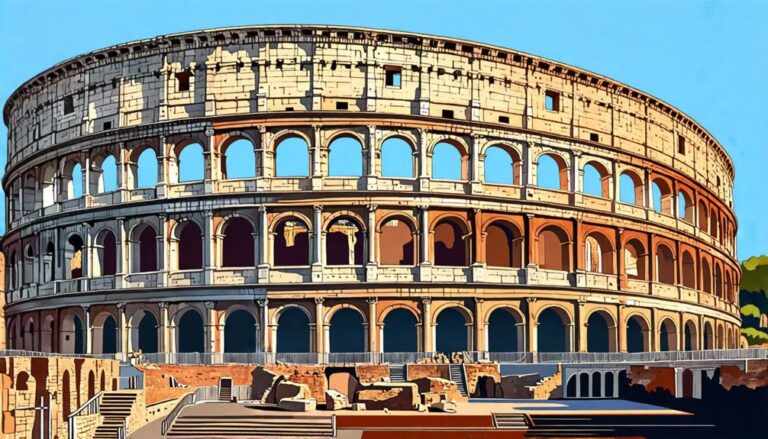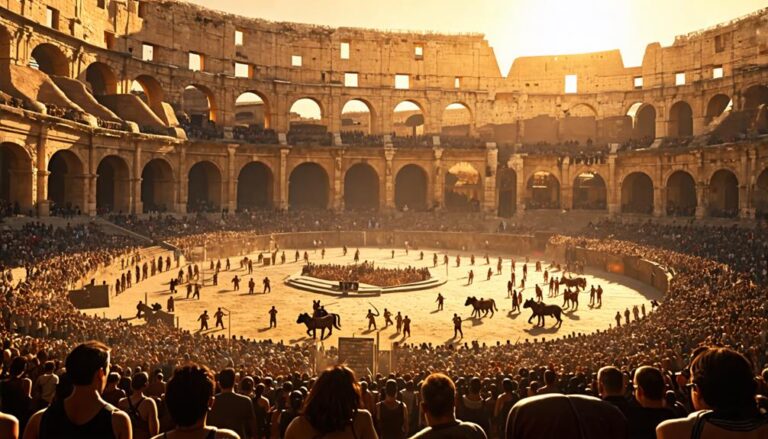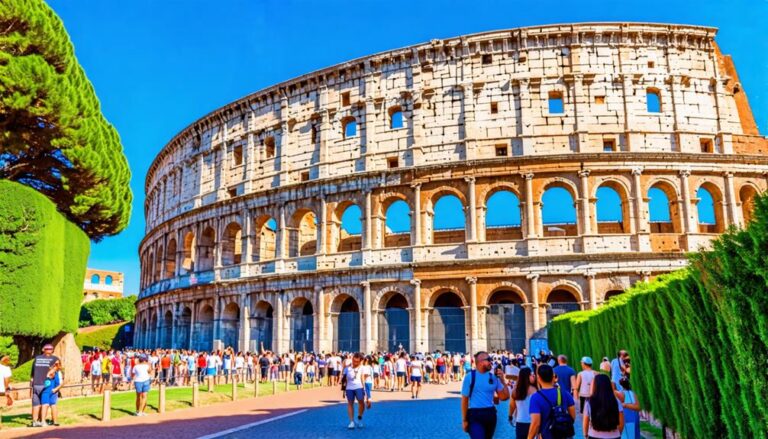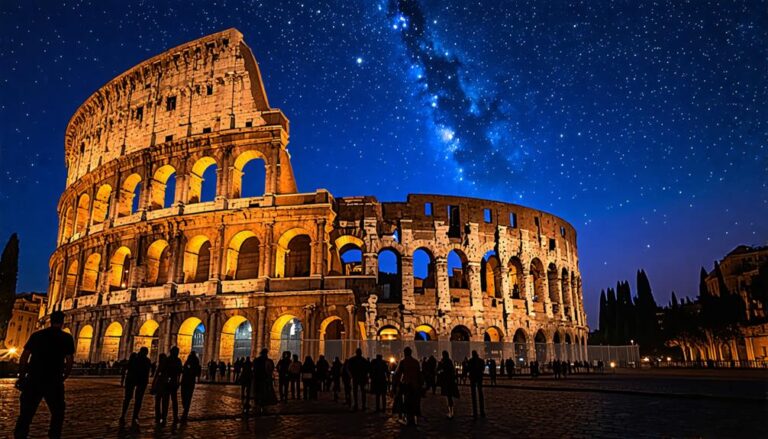Exploring the Underground of the Colosseum
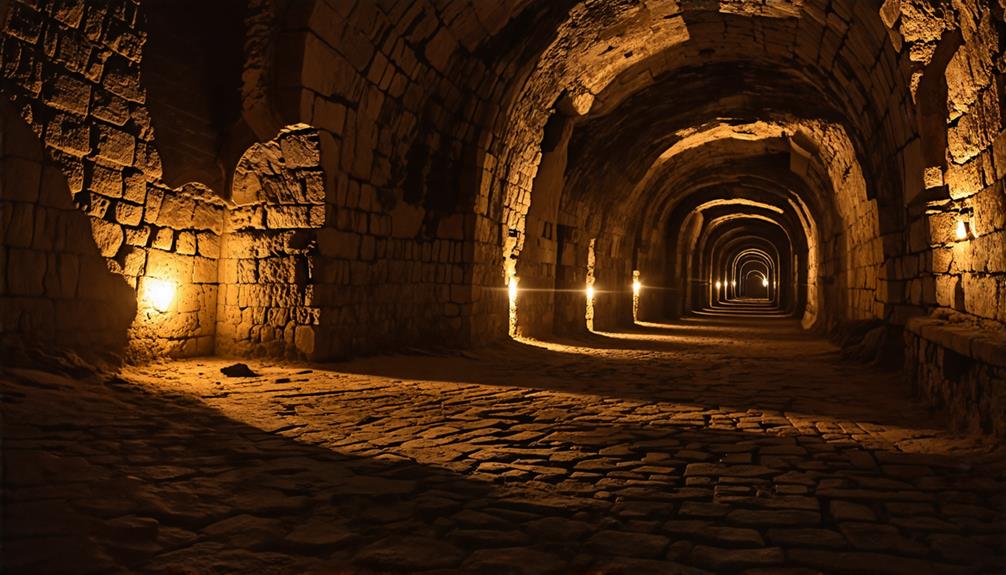
Exploring the underground of the Colosseum, known as the Hypogeum, immerses us in a maze of tunnels and chambers showcasing ancient Roman engineering genius.
This network, spanning about half a hectare, facilitated grand spectacles with mechanisms like hand-winch lifts and trapdoors for surprise entrances.
Here, gladiators trained under seasoned lanistae, and wild animals awaited their turn in the arena, highlighting Rome’s mastery over nature.
Guided tours reveal advanced sanitation corridors and intricate logistics that supported these events.
For a deeper understanding of its historical and architectural significance, there’s much more to uncover.
Key Takeaways
- The Hypogeum is an intricate underground network beneath the Colosseum. It was designed for gladiator and animal preparation.
- Guided tours unveil the brilliant Roman engineering, including hand-winch lifts and trapdoors.
- Visitors can explore dimly lit chambers where gladiators trained and animals were kept.
- The Hypogeum’s sophisticated drainage and sanitation systems showcase advanced ancient Roman practices.
The Colosseum, an iconic symbol of ancient Rome, offers a unique glimpse into the past. The Hypogeum, hidden beneath its grand structure, reveals the ingenuity and complexity of Roman engineering. It’s fascinating to see how they used hand-winch lifts to move heavy objects and trapdoors for dramatic effects during games.
Stepping into the dimly lit chambers, you can almost feel the history. These were the very spots where gladiators trained for combat and wild animals were kept before being released into the arena. The atmosphere is both eerie and captivating.
The advanced drainage and sanitation systems of the Hypogeum are a testament to Roman innovation. They managed to create a functional and efficient underground network that still impresses modern engineers.
With tours limited to just 12 guests, you get a truly personalized experience. The 1.5-hour tour allows plenty of time to soak in the history and marvel at the ancient architecture.
What Is the Hypogeum?
The Hypogeum, a crucial part of the Colosseum, is an intricate network of underground passages, chambers, and cells vital to the spectacles of ancient Rome. Beneath the grandeur of the Colosseum’s arena, the Hypogeum ensured the seamless execution of events that thrilled thousands. This elaborate subterranean world housed gladiators and wild animals, preparing them for their dramatic entrances.
Imagine the thrill of the audience, unaware of the complex preparations happening below. The Colosseum’s underground system had sophisticated machinery, enabling surprise entrances and dramatic effects that heightened excitement. This wasn’t just about entertainment; it was about creating a spectacle that left spectators in awe.
Spanning about half a hectare, the Hypogeum’s interconnected tunnels facilitated the arena’s logistical operations. It’s fascinating to think about how efficiently this underground labyrinth worked, ensuring everything above ground ran smoothly. Today, access to the Hypogeum is limited to guided tours, offering a unique glimpse into the behind-the-scenes workings of ancient Roman entertainment. As we explore these hidden corridors, we’re transported back to an era where freedom and spectacle intertwined in this remarkable underground world.
If you’re planning a vacation to Rome, visiting the Colosseum is a must. The guided tours of the Hypogeum offer an exclusive look into the history and engineering marvels of ancient Rome. Standing in the same spaces where gladiators once prepared for battle is an unforgettable experience. So, when in Rome, make sure to delve into the depths of the Hypogeum and witness firsthand the ingenuity of Roman entertainment.
Historical Significance
Understanding the historical significance of the Colosseum’s Hypogeum unveils much about ancient Rome’s engineering brilliance and societal values. The Hypogeum’s intricate network of passages, chambers, and holding cells wasn’t just an architectural marvel; it was a testament to Rome’s ingenuity. This subterranean labyrinth was essential for orchestrating the grand spectacles that captivated thousands of spectators.
When you start a Colosseum underground tour, you’ll gain a deeper appreciation for how the Hypogeum functioned as the heartbeat of the Colosseum. Its design included advanced mechanisms like trapdoors and hand-winch lifts, enabling dramatic entries and exits that intensified the excitement above ground. The Hypogeum’s role extended beyond mere logistics. It was pivotal in managing the aftermath of these brutal events, showcasing Rome’s ability to handle complex operations.
- Sophisticated engineering feats: Trapdoors and lifts for dramatic effects.
- Operational hub: Preparing gladiators and animals for the games.
- Societal reflection: Insight into Rome’s values on entertainment.
- Efficient waste management: Handling blood and waste from events.
Exploring this underground maze reveals not just the physical structure but the cultural heartbeat of a civilization that prioritized spectacle and engineering prowess.
Gladiator Preparation
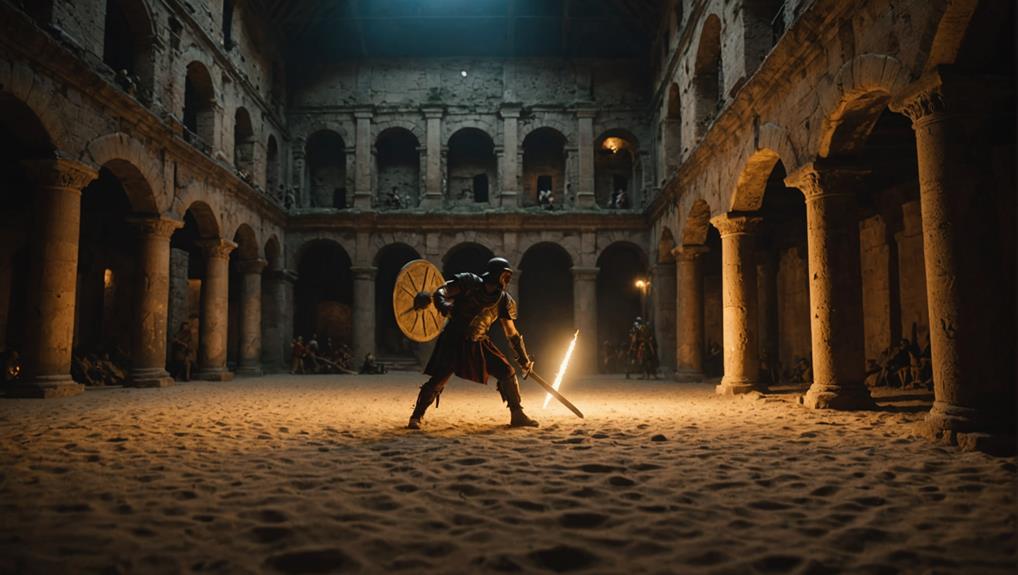
When you visit Rome, the Colosseum stands as a must-see marvel. Beneath this iconic structure lies the hypogeum, where gladiators prepared for their fierce battles. These fighters honed their skills and steeled their nerves in dimly lit chambers. The underground labyrinth was their home, filled with holding cells and rigorous training areas. Seasoned trainers, known as lanistae, oversaw their readiness for combat. Discipline was tough, and routines were grueling. Yet the allure of fame and potential wealth drove these warriors to push their limits.
Training wasn’t just about strength. Gladiators learned to wield various weapons and mastered hand-to-hand combat techniques. Defensive maneuvers were crucial for surviving the arena’s deadly confrontations. Even basic medical care kept them in peak condition.
The underground also featured intricate machinery and trapdoors. These added drama, enabling surprise entrances that thrilled the crowds above. This subterranean world was essential to the gladiatorial combat experience. Each gladiator’s journey to potential glory began here. By understanding their preparation, we gain deeper insight into ancient Roman entertainment.
Exploring the Colosseum and its hypogeum offers a fascinating glimpse into the past. It’s more than just a tourist spot; it’s a window into history.
Animal Housing
Vacations to Rome: Exploring the Colosseum
Within the Colosseum’s underground, wild animals like lions, bears, and elephants awaited their moment in specially designed holding cells. These enclosures were a key part of the labyrinthine tunnels, positioned for quick access and dramatic appearances during events.
Exploring animal housing reveals a complex system designed for various species. Each cell was planned to ensure the animals’ safety and manageability before their grand entrance into the arena.
The Hypogeum, the Colosseum’s subterranean network, featured an advanced system of cages and lifts. This infrastructure allowed for the efficient and surprising movement of animals to the arena floor, heightening the excitement for spectators.
These creatures’ presence was more than just entertainment; it showcased Rome’s dominance over nature, adding a powerful narrative to the games. The animals were integral to the spectacles, embodying the empire’s might and control.
- Strategically positioned enclosures
- Advanced system of cages and lifts
- Carefully planned cells for different species
- Showcase of Rome’s dominance over nature
Visiting the Colosseum today, you can still sense the grandeur of ancient Rome. Imagine the awe spectators felt as wild animals emerged from the depths of the Hypogeum.
The Colosseum remains a testament to Roman engineering and the empire’s power, making it a must-see on your Rome vacation.
Engineering Marvels
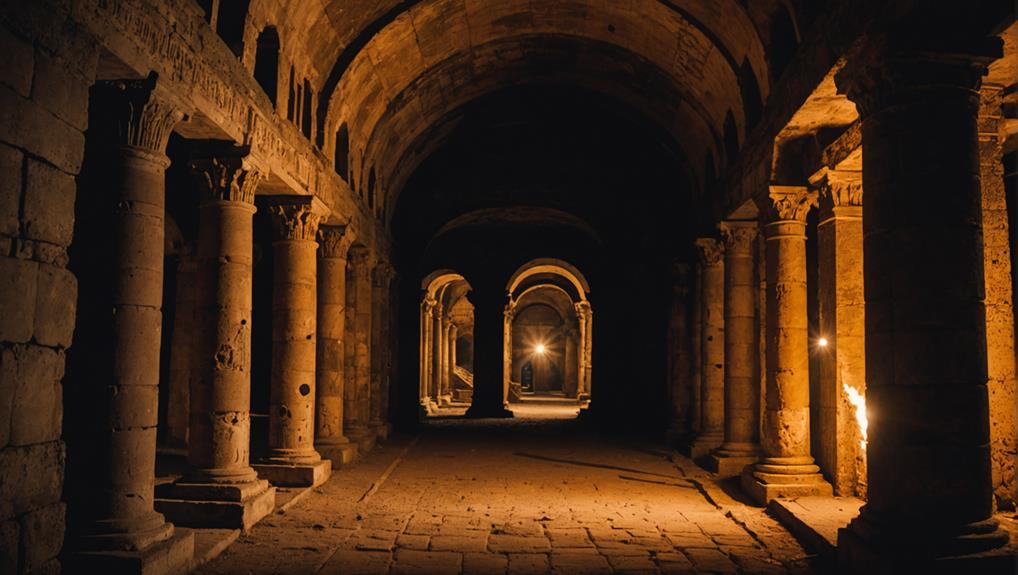
When you vacation in Rome, visiting the Colosseum is a must. As you explore the underground, you’ll be amazed at the advanced techniques the Romans used. The Hypogeum‘s intricate tunnels and chambers, combined with inventive arena mechanisms like freight elevators and hand-winch lifts, show their brilliance. These engineering wonders not only allowed gladiators and animals to move smoothly but also ensured the spectacle’s safety and dramatic impact.
The Colosseum’s Hypogeum, a complex network beneath the arena floor, served as the staging area for the grand events. According to historical records, it housed cages, lifts, and trapdoors. The Romans designed it to create surprise and excitement during the games.
Imagine the thrill of ancient spectators as they watched lions and tigers emerge from hidden chambers. These moments were made possible by the sophisticated engineering below.
Ancient Roman Engineering Techniques
The Colosseum’s underground hypogeum is a testament to ancient Rome’s advanced engineering techniques. This subterranean marvel, built with stone, marble, and concrete, shows the Romans’ skill in supporting the massive arena above while allowing participants to move through tunnels and chambers. Strategic control rooms at corridor ends further showcase Roman engineering sophistication.
Visitors can admire the Colosseum’s hypogeum for many reasons:
- Structural Durability: Stone, marble, and concrete ensured the hypogeum could bear the arena’s immense weight.
- Logistical Efficiency: Complex tunnels and chambers efficiently handled gladiators and animals.
- Hydraulic Engineering: Smart water and drainage systems managed blood and waste.
- Adaptation and Innovation: Replacing the wooden arena with a masonry floor improved safety and durability.
These engineering feats highlight ancient Rome’s architectural brilliance and ability to innovate. The Colosseum remains a lasting structure that continues to inspire awe.
When visiting Rome, seeing the Colosseum and its hypogeum should be a top priority. It provides a glimpse into the past and showcases the ingenuity of Roman engineering.
Innovative Arena Mechanisms
Ingenious mechanisms like hand-winch lifts and trapdoors made the Colosseum’s underground a marvel of ancient engineering. These innovative arena mechanisms allowed gladiators and animals to appear suddenly in the arena, adding an element of surprise that thrilled the audience. The Colosseum Underground was a bustling hub of activity, enabling seamless shifts between the spectacles above and the preparations below.
The corridors, designed with efficiency in mind, facilitated the movement of up to 30,000 spectators, ensuring quick access through 80 entrances. Originally constructed with a wooden floor, the arena’s surface was later upgraded to a masonry structure, enhancing durability and safety for grand events, including naval battles and animal hunts.
The Romans’ engineering prowess extended to an intricate drainage and water management system, addressing sanitation needs by efficiently handling blood and waste from the events. The underground complex itself spanned half a hectare, boasting 14 symmetrically arranged corridors around a central passage, serving as holding cells for wild beasts and logistical support for arena operations.
Here’s a quick look at some of the Colosseum’s innovative mechanisms:
| Mechanism | Function |
|---|---|
| Hand-winch lifts | Transported gladiators and animals |
| Trapdoors | Enabled sudden appearances in the arena |
| Corridors | Facilitated spectator movement |
| Drainage system | Managed blood and waste |
These features highlight the incredible ingenuity and foresight of ancient Roman engineers.
Machinery and Traps
Beneath the Colosseum lies a marvel of Roman engineering. Sophisticated machinery and intricate traps played a vital role in the grand spectacles above. Imagine how these hidden mechanisms contributed to the drama and excitement of the events.
The Colosseum’s underground area featured various machinery, including hand-winch lifts. These lifts quickly transported gladiators and wild animals to the arena floor, keeping the show lively. Trapdoors were strategically placed to allow for surprise entrances, adding unpredictability to the spectacles. The tunnels and chambers below buzzed with activity, managing logistics to keep events running smoothly.
These feats of engineering showcase the Romans’ advanced knowledge of hydraulics and mechanics, essential for orchestrating such large-scale events. The design also included a drainage system to handle blood and waste, keeping the arena functional and clean.
- Hand-winch lifts for quick movement of participants
- Trapdoors for dramatic and surprise entrances
- Complex tunnel and chamber systems for logistics
- Advanced understanding of hydraulics and mechanics
Exploring these underground features highlights the ingenuity and foresight of Roman engineers.
When you visit Rome, the Colosseum is a must-see. Its underground area offers a glimpse into the past, showing how advanced and well-planned Roman engineering was. This adds a unique layer to your sightseeing experience in Rome. You can almost hear the echoes of history as you walk through these ancient tunnels.
The Colosseum is more than a structure; it’s a testament to human creativity and the drive to entertain.
Behind-the-Scenes Magic
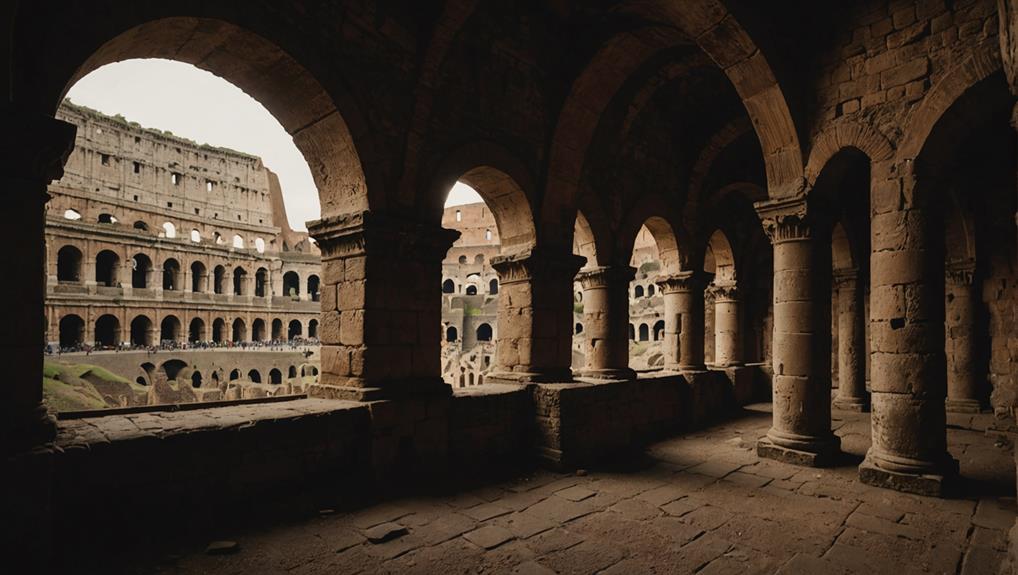
Exploring the Colosseum’s Underground reveals the hidden operations that made ancient Roman spectacles truly magical. This subterranean labyrinth, known as the Hypogeum, was the nerve center for gladiatorial games and animal hunts. Its intricate network of tunnels and chambers allowed for flawless event coordination, ensuring that every moment was meticulously planned and executed.
The Hypogeum had holding cells for wild animals and gladiators, giving a glimpse into the rigorous preparations before each grand spectacle. Ingenious engineering designs, such as hand-winch lifts and trapdoors, enabled gladiators and animals to appear suddenly in the arena, capturing the audience’s awe. These elements highlight the Romans’ advanced technological prowess and their flair for dramatic presentation.
| Feature | Purpose | Impact on Events |
|---|---|---|
| Hand-winch lifts | Elevate gladiators and animals | Dramatic surprises for the audience |
| Trapdoors | Sudden appearances in the arena | Heightened suspense and excitement |
| Holding cells | Secure animal and gladiator storage | Efficient event preparation |
| Sanitation corridors | Manage blood and waste | Improved hygiene and infrastructure |
Tours of the Colosseum Underground offer exclusive access to these restricted areas. They allow us to connect with the historical significance and operational secrets of Roman entertainment. Exploring this hidden world, we gain a deeper appreciation for the ingenuity and spectacle that defined ancient Rome.
Archaeological Discoveries
Recent archaeological discoveries in the Colosseum’s underground have revealed an array of artifacts and structures that enhance our grasp of ancient Roman entertainment. For those vacationing in Rome, a visit to the Colosseum offers an unparalleled journey into history. The ingenuity and complexity of the Romans are truly remarkable.
Excavations have uncovered a maze of tunnels and chambers, once filled with gladiators and wild animals waiting for their turn in the arena. The findings include remnants of ancient machinery like hand-winch lifts and trap doors, which elevated these spectacles to astonishing levels. These discoveries highlight the engineering skill that allowed the Romans to create such dramatic events. Unearthed drainage systems show their advanced understanding of sanitation, effectively managing the blood and waste from the arena.
Artifacts like weapon fragments, armor pieces, and animal bones tell stories of the battles fought and the lives lived within these walls. These findings offer a vivid glimpse into the world that once was, shedding light on the logistics and scale of the grand events that captivated Roman spectators.
Visitor Experience
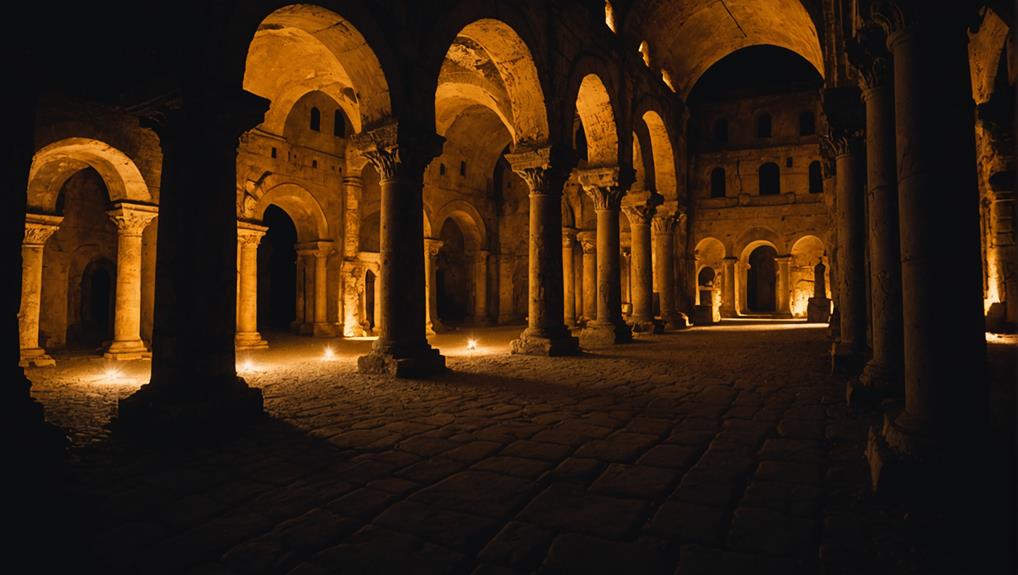
Visitors to the Colosseum Underground begin an intimate, guided tour that brings ancient Roman history to life. Limited to just 12 guests, our small group guarantees a personalized and engaging experience as we explore hidden chambers and corridors beneath the iconic amphitheater. Over 1.5 hours, we investigate the intricacies of these subterranean spaces, once bustling with gladiators and wild beasts.
Access to the Colosseum Underground is exclusive to guided tours. Expert guides offer insights and anecdotes that enrich our understanding of this historical marvel. As we navigate the original structures, we encounter fascinating features such as trapdoors used for surprise entrances during ancient spectacles. These elements offer a unique perspective on the logistics of Roman entertainment and the engineering prowess of the era.
We experience a visceral connection to the past. Immersive storytelling and historical context evoke the sounds and atmosphere of gladiatorial combat, making the ancient world tangible. This journey through the Colosseum Underground deepens our appreciation for Roman history and sparks a sense of freedom as we connect with the timeless human spirit.
Tour Highlights
As we explore the underground of the Colosseum, we’ll uncover the hidden tunnels and chambers essential for staging grand spectacles. We’ll marvel at ancient engineering feats, including hand-winch lifts and trapdoors that added drama to the events. Our VIP access guarantees an intimate experience, allowing us to walk through dimly lit corridors and hear enthralling stories that bring history to life.
The Colosseum, or Flavian Amphitheatre, stands as a testament to Roman ingenuity. Built in AD 80, it hosted gladiatorial contests and public spectacles. The underground area, known as the hypogeum, housed animals and gladiators before their grand entrance. This labyrinth of passageways and cells reveals the behind-the-scenes workings of ancient Rome’s most famous arena.
Our tour offers a rare glimpse into these subterranean spaces. Walking through these dark passages, you’ll feel the weight of history. Imagine the roar of the crowd above and the tension below as events unfolded. This unique access lets us connect with the past in a way few experiences can.
Historically, the Colosseum could hold up to 80,000 spectators. It featured a complex system of vaults and corridors that efficiently managed the flow of people and events. The hypogeum contained elevators operated by winches, which lifted animals and scenery to the arena floor. This innovation added an element of surprise and excitement to the spectacles.
Our journey through the underground of the Colosseum offers more than just a tour—it’s a portal to ancient Rome. With each step, you’ll gain a deeper understanding of the ingenuity and grandeur that defined this iconic structure. Join us as we delve into the shadows of history and uncover the secrets of the Colosseum.
Hidden Tunnels Exploration
Exploring the hidden tunnels of the Colosseum reveals a maze of chambers and passages that once powered the grand events of ancient Rome. This underground network was the core of the Colosseum, managing gladiatorial games and animal hunts. Walking through these dimly lit corridors, we can almost hear echoes of the past, feeling the tension and excitement that once filled these spaces.
The underground of the Colosseum offers a treasure trove of historical insights. Here are some highlights:
- Holding Cells: These housed wild beasts and gladiators, shedding light on the preparation and logistics involved.
- Hand-Winch Lifts: Ingenious devices that enabled dramatic reveals during events.
- Trap Doors: Secret elements that added surprise and suspense to the spectacles.
- Water and Drainage System: A sophisticated setup to manage blood and waste, ensuring the arena remained clean.
Walking through these hidden tunnels, we grasp the complexity and ingenuity that created spectacles captivating ancient Rome’s citizens. The underground truly brings history to life.
For anyone planning a vacation to Rome, a visit to the Colosseum’s hidden tunnels offers a unique glimpse into the past. It’s an essential part of sightseeing, providing a deeper understanding of how this iconic structure operated.
Ancient Engineering Marvels
How did ancient Romans create such an intricate network beneath the Colosseum, blending innovation with practicality to orchestrate their grand spectacles? They constructed a complex underground labyrinth spanning about half a hectare. This network of passages and chambers allowed seamless operation of events above.
The Colosseum’s subterranean area was an ancient engineering marvel. Using hand-winch lifts and hidden trap doors, gladiators and wild animals could make dramatic entrances into the arena. Holding cells for beasts and a sophisticated drainage system guaranteed efficient management of blood and waste from brutal spectacles.
Originally built with wood, the arena floor was later transformed into a durable masonry structure under Emperor Domitian. This upgrade enhanced both safety and longevity. The symmetrical arrangement of fourteen corridors leading to control rooms demonstrated the advanced logistical planning of Roman entertainment.
Here’s a glimpse at some of the Colosseum’s engineering highlights:
| Feature | Function |
|---|---|
| Hand-winch lifts | Elevated gladiators and animals into the arena |
| Hidden trap doors | Enabled surprise entrances |
| Holding cells | Contained wild beasts before release |
| Sophisticated drainage | Managed blood and waste efficiently |
| Masonry arena floor | Enhanced durability and safety |
These ancient engineering marvels exemplify the Romans’ ingenuity, allowing them to host unforgettable spectacles within the arena.
VIP Access Experience
Exploring the underground of the Colosseum through the VIP Access Experience offers a rare glimpse into the ancient world’s spectacle machinery. As we delve into the depths of this iconic landmark, we’re granted exclusive access to the very heart where gladiators and wild beasts awaited their fate.
This isn’t just a tour; it’s a time-travel journey, limited to just 12 guests, ensuring a personal and intimate experience guided by experts. Our exploration includes the interconnected tunnels that once buzzed with activity, the holding cells where the wild beasts were kept, and the ingenious trapdoors that created dramatic entrances in the arena.
We learn about the ancient Romans’ engineering marvels, such as hand-winch lifts and a sophisticated drainage system designed to manage blood and waste.
Here are some highlights of the VIP Access Experience:
- Exclusive access to the Colosseum Underground
- Intimate tour groups with a maximum of 12 guests
- Personalized attention from expert guides
- Insights into ancient Roman engineering, including hand-winch lifts
This VIP Access Experience offers a unique perspective, blending history, engineering, and the thrill of the ancient world’s most spectacular events.
Restricted Areas
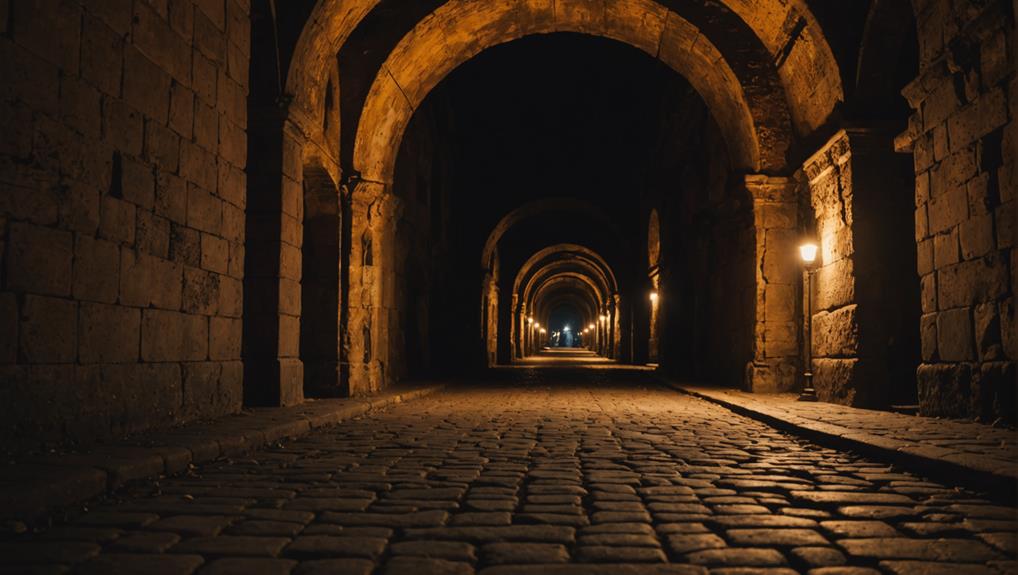
The Colosseum’s grandeur is evident from above, but the restricted underground areas reveal the true ingenuity of ancient Roman engineering. The Colosseum Underground, or Hypogeum, is a maze of passages, chambers, and cells that supported grand spectacles like gladiatorial combat and wild animal hunts. This hidden world is limited to guided tours, offering an intimate and educational experience for those lucky enough to gain access.
Imagine descending into the depths where gladiators awaited their fate and wild animals were kept in cramped cells. The Hypogeum had sophisticated hand-winch lifts and hidden trapdoors for dramatic entrances into the arena. The two-level design also included an advanced water and drainage system, essential for managing blood and waste during brutal events.
Access to these areas requires more than curiosity. Visitors must provide full names and undergo passport verification. Tickets are non-refundable and non-exchangeable. This level of security ensures that only the truly dedicated can explore this fascinating aspect of Roman history, making the experience exclusive and memorable.
Booking Information
Securing tickets for the Colosseum Underground requires advance planning due to their limited availability and high demand. When booking a Colosseum Underground tour, you must act quickly because these coveted spots often sell out well in advance. Here’s a streamlined guide to help you navigate the process:
- Advance Booking: Tickets must be booked ahead of time to guarantee entry.
- Participant Information: Full names of all participants are required during booking for security and verification.
- Passport Verification: Entry necessitates showing passports at the entrance for identity confirmation.
- Non-refundable Tickets: Tickets are non-refundable and non-exchangeable, so careful planning is vital.
Booking a Colosseum Underground tour involves more than just purchasing a ticket. Every detail must be meticulously planned to avoid any last-minute disappointments.
The thorough verification process underscores the significance of security and authenticity for all visitors. Though the Underground tour offers an unparalleled glimpse into history, alternative tours still provide an enriching experience of this iconic structure.
Plan wisely and embrace the freedom to explore this ancient marvel.
Accessibility Tips
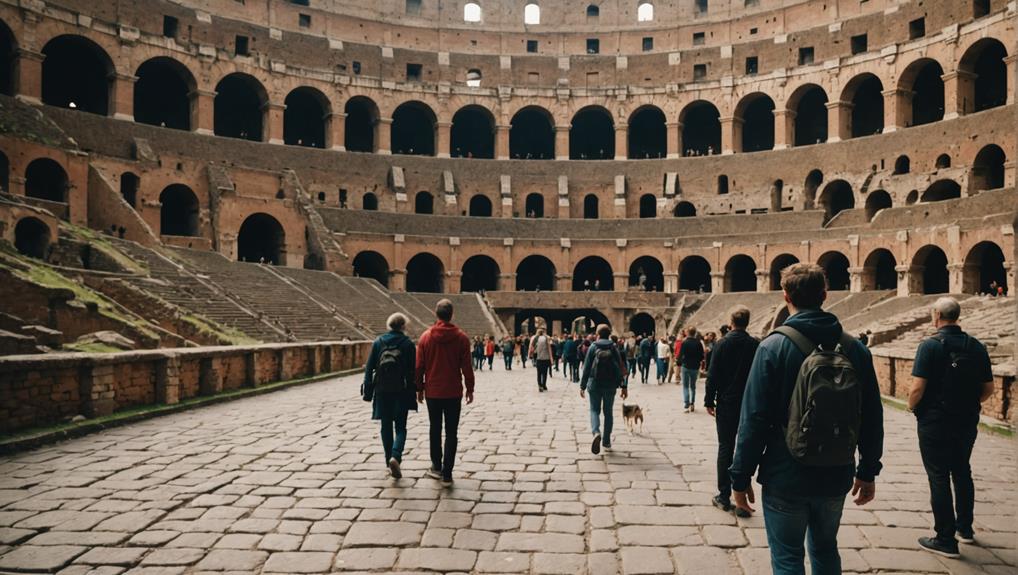
When planning our visit to the underground of the Colosseum, we should consider entry points, mobility assistance options, and the advantages of guided tours.
Uneven surfaces and narrow passages need special attention, making sturdy footwear and early booking vital. Guided tours not only provide expert insights but also ensure we navigate accessible routes effectively.
The Colosseum, an ancient Roman amphitheater, has a rich history dating back to 70-80 AD. It once hosted gladiatorial contests and public spectacles. Today, it stands as a magnificent symbol of Rome’s architectural ingenuity. Exploring its underground chambers reveals the intricate network of tunnels where gladiators and animals awaited their turn in the arena.
Mobility assistance options, such as wheelchairs and ramps, are available for those who need them. Booking these in advance can make the visit more comfortable. The guided tours, led by knowledgeable historians, offer a deeper understanding of the Colosseum’s engineering marvels and the daily life of ancient Romans.
Sturdy footwear is essential due to the uneven surfaces. These surfaces have been worn down by centuries of use, adding to the historical ambiance of the site. Early booking is crucial to secure a spot, as the Colosseum is a popular tourist attraction.
Entry Points Information
Vacations to Rome Colosseum: Sightseeing Tips
Visitors should book guided tours well in advance to secure access to the Colosseum Underground. With limited capacity and high demand, planning early is crucial. Upon arrival, provide full names and passport verification for security and adherence to policies. This step is essential for exploring the Underground areas, rich in historical intrigue and architectural marvels.
Navigating the Underground can be challenging due to its uneven surfaces and narrow passages. Comfortable footwear is a must for a pleasant experience. Arriving early is also essential, as entry to the Underground is restricted to specific scheduled tours. This ensures we secure our time slots and avoid unnecessary delays.
Here are some tips for a smooth visit:
- Book tours well in advance: Secure your spot.
- Provide necessary identification: Full names and passport verification are required.
- Wear comfortable footwear: Uneven surfaces and narrow passages make sturdy shoes essential.
- Arrive early: Early arrival helps secure your time slot for the tour.
Enjoy your visit to this iconic Roman landmark!
Mobility Assistance Options
Visiting the Colosseum in Rome is a must for anyone on vacation, even for those of us with mobility challenges. The Colosseum Underground offers various accessibility options to ensure an inclusive and enjoyable visit. Although the Underground has uneven surfaces and tight passages, measures are in place to help us explore.
When we arrive, we’ll find ramps at the main entrance. However, be ready for some uneven ground within the Underground itself. Guided tours often cater to individuals with mobility challenges. These tours provide assistance and allow for a slower-paced exploration.
It’s smart to contact tour operators in advance to discuss specific needs. This helps ensure a smooth and inclusive experience. Wearing comfortable shoes is highly recommended. For extra support, we might consider using a wheelchair or other mobility aids.
These mobility assistance options can greatly enhance our ability to navigate the Colosseum Underground. They make the experience more enjoyable and less strenuous.
Guided Tour Benefits
Guided tours of the Colosseum Underground offer invaluable benefits for those seeking accessibility and expert insights. These tours, lasting about 1.5 hours, allow ample time to explore comfortably.
One standout benefit is the exclusive access to the Underground, areas usually off-limits to the general public. This means we get to experience hidden historical gems with expert commentary, enhancing our understanding and appreciation of this iconic structure.
However, the uneven surfaces and narrow passages of the Underground require consideration. Visitors with mobility challenges should assess their comfort levels before booking.
Planning ahead is essential due to the limited availability of tickets, which are non-refundable and non-exchangeable. Here is a quick rundown of the accessibility tips and benefits:
- Exclusive access: Available only via guided tours, ensuring a unique experience.
- Expert insights: Guides offer historical context and fascinating details.
- Ample exploration time: Tours last about 1.5 hours, balancing depth with comfort.
- Early booking: Necessary due to high demand and limited tickets.
Family-Friendly Aspects
Families often find the Colosseum Underground tour fascinating and manageable. It provides an engaging historical experience tailored for older children. This tour offers a unique glimpse into the lives of gladiators and the inner workings of ancient Rome‘s grand entertainment arena. With a duration of about 1.5 hours, the tour is perfect for families seeking an educational outing that won’t overwhelm younger visitors.
The underground area is less crowded, giving us the freedom to explore at our own pace. We can fully immerse ourselves in the ancient world, hearing expert anecdotes and stories that bring history to life. Access to the Colosseum Underground is exclusively through guided tours, ensuring rich historical context and engaging storytelling throughout our visit.
Our children will be captivated by the engineering marvels of ancient Rome, including the intricate tunnels and trapdoors used during thrilling arena spectacles. This intimate experience allows us to appreciate the ingenuity and craftsmanship that went into the Colosseum’s construction. By the end of the tour, our family will have a deeper understanding of this iconic monument, making the trip both educational and memorable.
The Colosseum, also known as the Flavian Amphitheatre, is an architectural wonder. Built between 70–80 AD, it remains one of the greatest works of Roman engineering. Its underground chambers reveal the complex systems used to stage elaborate games and gladiator battles. The attention to detail and innovative designs are a testament to the advanced skills of Roman engineers.
Exploring the Colosseum Underground offers a rare opportunity to connect with the past. Walking through the same corridors where gladiators once prepared for combat provides a tangible link to history. This tour adds depth to any Rome vacation, making it a must-see for families interested in the rich heritage of ancient civilizations.
Additional Attractions
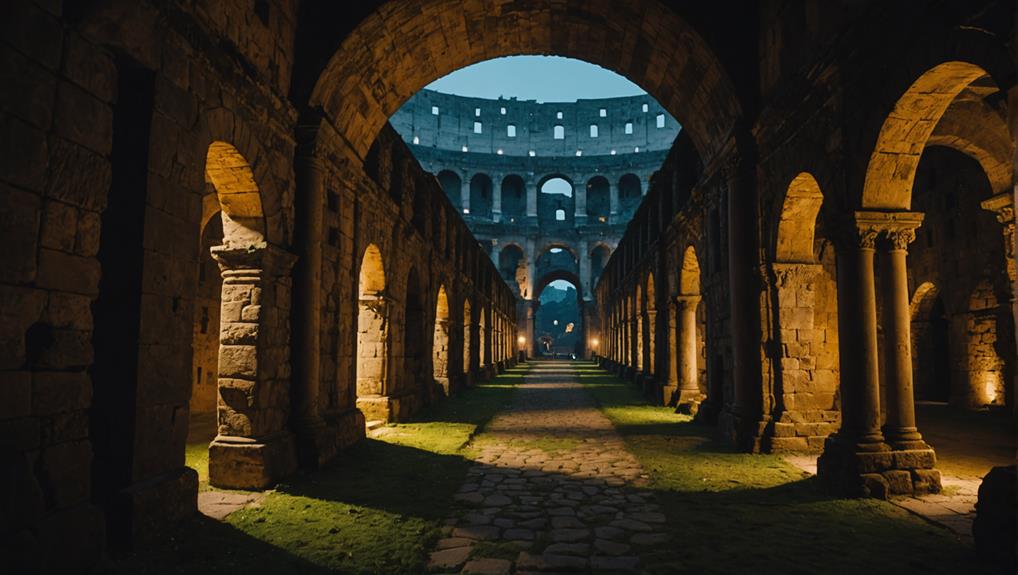
Nearby, we can’t overlook the Roman Forum. This was the center of ancient Rome’s political, social, and economic life. Here, we can explore significant structures like the Senate House.
Next, we can head to Palatine Hill. This spot offers stunning views and lets us walk among the ruins of emperors’ palaces.
These attractions add a rich context that complements our Colosseum visit. By exploring these sites, we deepen our understanding of Rome’s extensive history.
Roman Forum Highlights
The Roman Forum is a treasure trove of history. It showcases landmarks like the Temple of Vesta and the Arch of Septimius Severus. Exploring this heart of ancient Roman life, you marvel at how these remnants connect us to a thriving past. The Forum, nestled between the grandeur of the Colosseum and the heights of Palatine Hill, reflects Rome’s enduring legacy.
Imagine standing before the Temple of Vesta. Here, the eternal flame of Rome was fiercely guarded by the Vestal Virgins. Nearby, the Arch of Septimius Severus rises majestically, commemorating Rome’s triumph over the Parthians. Each step through this historic expanse reveals new layers of the past. You see Julius Caesar’s cremation site and the imposing basilicas that once housed the epicenter of Roman law, finance, and politics.
Key highlights within the Roman Forum include:
- Temple of Vesta: Eternal flame maintained by Vestal Virgins.
- Arch of Septimius Severus: Monumental tribute to Rome’s victory.
- Julius Caesar’s Cremation Site: Historical landmark.
- Basilicas: Centers for law, finance, and politics.
This exploration gives you a glimpse into the lives of those who shaped history.
Visiting the Roman Forum is a must when vacationing in Rome. It’s part of a journey through time, standing in the shadows of the Colosseum and Palatine Hill. The stories these stones tell make your trip unforgettable.
Palatine Hill Views
How can we resist the allure of Palatine Hill, where history and breathtaking views converge? As we ascend this celebrated hill, one of Rome’s original seven, we enjoy panoramic vistas of the Roman Forum and the Circus Maximus. The sense of freedom is palpable, as fewer crowds allow us to soak in the historical significance and natural beauty surrounding us.
Palatine Hill isn’t just about scenic views; it’s a journey through time. Believed to be the site where Rome was founded, this hill was once home to several imperial palaces, including that of Augustus. Walking through the ruins of the House of Augustus, we marvel at the well-preserved frescoes and landscaped gardens, a reflection of Roman elite living.
The Palatine Museum adds another layer to our exploration. Artifacts and sculptures reveal the grandeur of ancient Roman life and the magnificence of the emperors’ residences. The tranquility of Palatine Hill contrasts starkly with the bustling Colosseum, offering us a peaceful yet profound connection to Rome’s storied past.
In every corner, we find history intertwined with natural splendor, making our visit unforgettable.
Frequently Asked Questions
Can You Visit the Colosseum Underground Without a Tour?
Visiting the Colosseum Underground on your own isn’t possible. Access is strictly limited to guided tours. Booking in advance guarantees your spot.
The Colosseum, an ancient marvel, offers a glimpse into Rome’s storied past. Exploring its underground chambers reveals where gladiators once prepared for battle. These tours provide unique insights into history and architecture.
Plan your visit early. Tours can fill up quickly due to high demand. This ensures you experience this iconic site fully.
What Does the Colosseum Underground Tour Include?
The Colosseum underground tour offers special access to the hypogeum’s ancient structures. Visitors explore the tunnels, chambers, and trapdoors of this historic marvel. The tour reveals Roman engineering feats and provides a guided experience rich in detail and insight.
How to Go Underground at the Colosseum?
To explore the Colosseum’s underground, book a guided tour in advance. Provide full names and passport details for verification. Plan ahead due to limited capacity. Wear sturdy shoes for navigating rugged terrain.
What Is the Difference Between the Colosseum Underground and the Arena?
The Colosseum Underground showcases intricate passageways and chambers, designed for operational logistics. This contrasts with the Arena’s open floor, made for public viewing. The Underground’s exclusivity adds to its mystique, while the Arena’s accessibility symbolizes freedom for all visitors.
If you’re planning a vacation to Rome, exploring both areas of the Colosseum offers unique experiences. The Underground reveals the hidden mechanisms and pathways used by gladiators and animals before their grand entrance. It’s a maze of history, giving you a sense of the complex operations behind the spectacles.
On the other hand, the Arena floor lets you stand where ancient Romans once cheered and gasped. You can feel the vastness and imagine the roar of the crowd. It’s open and majestic, giving a sense of the grandeur of Roman architecture.
Both parts of the Colosseum provide a deep dive into history, but from different perspectives. The Underground tells a story of preparation and suspense, while the Arena tells a story of glory and spectacle. Visiting both gives a fuller picture of this iconic landmark.
Conclusion
Exploring the underground of the Colosseum reveals its intricate hypogeum, a network of tunnels and chambers. This space held gladiators and wild beasts before they entered the arena. The engineering marvels here show the Roman Empire’s advanced techniques.
The Colosseum, once a place of chaos and combat, now stands as a symbol of human ingenuity. Planning a visit involves checking for accessibility and family-friendly options.
It’s fascinating how this historic battleground has become an educational wonder.
